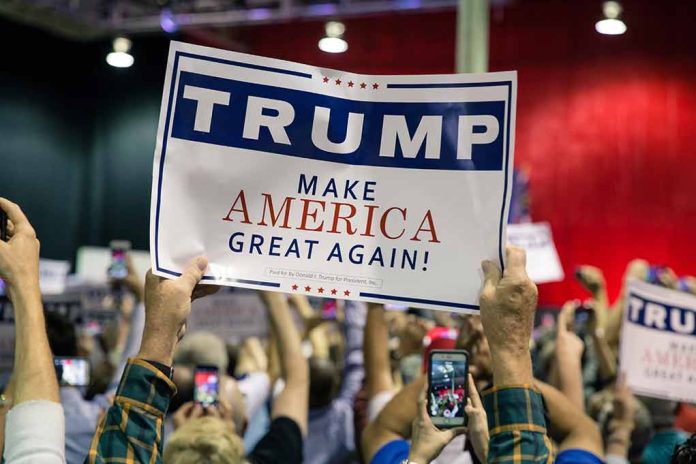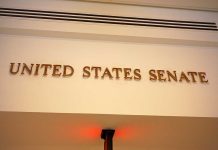
President Trump’s unprecedented 140+ executive orders in his first 100 days demonstrate decisive action to reclaim America from leftist policies, despite facing legal challenges and opposition from established institutions.
Key Takeaways
- President Trump has signed over 140 executive orders in his first 100 days, setting a historic record and demonstrating his commitment to swift action.
- Immigration enforcement has been dramatically strengthened, resulting in significant drops in illegal southern border crossings and increased deportations of illegal immigrants.
- Trump’s aggressive tariff policies, including a 145% rate on Chinese goods, are designed to protect American industries and correct trade imbalances.
- Federal workforce reductions and spending cuts led by Elon Musk’s efficiency efforts have trimmed government bloat, saving taxpayers billions.
- Despite legal challenges from leftist institutions, Trump continues to fulfill campaign promises through executive action rather than waiting for congressional approval.
Record-Breaking Executive Action to Restore America
President Trump has wasted no time implementing his America First agenda during his second term, issuing over 140 executive orders in his first 100 days—far surpassing any president in modern history. This remarkable pace demonstrates Trump’s determination to cut through bureaucratic red tape and deliver immediate results to the American people. The president’s bold approach has allowed him to rapidly implement policies addressing illegal immigration, trade imbalances, government inefficiency, and foreign policy challenges without being hindered by congressional gridlock or obstruction from establishment politicians who have historically delayed conservative priorities.
These executive actions have proven especially effective in areas where previous administrations failed to make meaningful progress. By taking decisive action through executive orders, Trump has been able to bypass the typical Washington delay tactics that often prevent meaningful conservative policies from being implemented. Critics have questioned the scope of these orders. Still, supporters point to the immediate positive impacts, particularly in areas like immigration enforcement and government spending reduction, which directly address key voter concerns from the 2024 election.
During his first 100 days back in office, President Trump has signed 140 executive orders.
He has signed 5 laws passed by Congress. https://t.co/y6RQfrsSAS
— NBC News (@NBCNews) April 30, 2025
Securing the Border and Enforcing Immigration Laws
President Trump’s immigration policies have produced immediate results that the Biden administration failed to achieve in four years. His executive actions on immigration enforcement have led to a sharp decline in illegal southern border crossings and significantly increased deportations of individuals who entered the country illegally. By reinstating effective enforcement mechanisms and removing incentives for illegal entry, the administration has begun addressing one of the most pressing national security and economic concerns facing everyday Americans who have watched their communities transformed by unchecked illegal immigration.
“None of those had the kind of arbitrary, forceful quality of Trump’s actions,” said John Woolley.
While legal challenges have temporarily halted some deportation efforts, including a Supreme Court intervention regarding the Alien Enemies Act, the administration remains committed to its core promise of enforcing immigration laws. The president’s actions have been met with strong approval from voters who recognized the border crisis as a direct result of the previous administration’s policies. By prioritizing American citizens and legal immigrants over those who violate our laws, Trump has demonstrated his commitment to restoring order and the rule of law at our borders. Rebalancing Trade and Protecting American Industry
President Trump’s aggressive trade policies have sent a clear message to nations that have taken advantage of American markets. By implementing tariffs on nearly all trading nations, including a substantial 145% tariff on Chinese goods, Trump addresses decades of unfair trade practices that have hollowed out American manufacturing and shipped jobs overseas. The administration’s approach aims to level the playing field and pressure trading partners to negotiate fair agreements that benefit American workers and businesses rather than foreign competitors who have exploited access to our markets.
“I believe that it’s up to China to de-escalate because they sell five times more to us than we sell to them,” said Treasury Secretary Scott Bessent.
While some economists have expressed concerns about potential market disruptions, supporters argue that these short-term adjustments are necessary to correct long-standing trade imbalances that have disadvantaged American producers. The administration’s willingness to use tariffs as leverage demonstrates a commitment to protecting domestic industries and ensuring that trade relationships work for the American people rather than multinational corporations seeking cheap labor markets. This approach stands in stark contrast to previous administrations that allowed American manufacturing to decline in pursuit of globalist economic policies.
Streamlining Government and Cutting Wasteful Spending
In partnership with Elon Musk, President Trump has launched an aggressive effort to reduce government bloat and inefficiency. The initiative has already resulted in approximately 280,000 federal workforce reductions through firings, buyouts, and proposed cuts, targeting departments and programs that have expanded well beyond their intended scope. These efforts represent a significant departure from the typical Washington approach of continually growing government regardless of effectiveness or outcomes, instead focusing on accountability and results for taxpayer dollars.
Major cuts to foreign aid and various government departments reflect the administration’s commitment to prioritizing American needs over international obligations that often provide little benefit to citizens. The efficiency drive has faced resistance from entrenched bureaucrats and the administrative state, but continues to advance with strong support from voters who elected Trump specifically to drain the Washington swamp and reduce the federal government’s overreach into American life and business.
Overcoming Resistance to America First Priorities
President Trump’s aggressive use of executive authority reflects the reality that established institutions often resist meaningful change. By using executive orders to implement his agenda, Trump has demonstrated his commitment to delivering on campaign promises even when faced with institutional opposition. Legal challenges to these executive actions have been filed by left-leaning organizations and individuals who benefited from the previous status quo, but the administration continues to advance its policies while defending them in court.
The pace and scope of executive actions indicate that Trump is determined to accomplish as much as possible regardless of congressional cooperation. This approach acknowledges the practical realities of governance in a divided Washington, where obstructionism has often prevented substantive policy changes. By prioritizing immediate action over endless deliberation, Trump has shown taxpayers that their concerns about border security, economic fairness, and government waste are being addressed rather than studied indefinitely in committees.
“There is nothing to talk about — it is our land, the land of the Ukrainian people,” said Ukrainian President Volodymyr Zelenskyy.
As President Trump marks 100 days in office, his record-breaking executive action demonstrates a commitment to fulfilling the mandate given by voters who elected him to restore America’s strength, security, and prosperity. While debates about constitutional authority and economic impacts continue, supporters see these executive orders as necessary to overcome the resistance of entrenched interests that have long prevented meaningful conservative reforms. The administration’s willingness to act decisively, even in the face of legal challenges, provides a stark contrast to previous Republican administrations that often failed to deliver on campaign promises.













